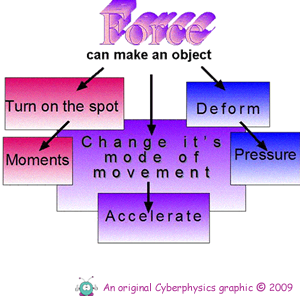|
||||||||||||||||||
|
Unit of force
Forces are measured in newtons (N).
The unit us named after the famous scientist Sir Issac Newton.
The newton (note that we start it with a smallcase letter) is the unit of force.
The abbreviation for a newton is N (must be a capital 'N')
Definition:
One newton is the force needed to give a mass of one kilogram an acceleration of one metre per second squared.
Driving forces and counter (resistive) forces
Forces are vectors. This means that as well as their size (sometimes called 'magnitude', the direction they act in matters. When you add them together you have to consider this.
Driving Forces
Forces that push an object in the direction it is already travelling make it accelerate (speed up!).
These forces are called driving forces.
Friction is never a driving force!
Gravity is a driving force if you are going downhill and the wind is a driving force if it is at your back -
but a counter-force if you are going uphill!
Counter Forces or Resistive Forces
Forces that push an object in the opposite direction to that it is already travelling in make it decelerate - undergo negative acceleration or slow down. These forces are called counter forces or resistive forces.
Friction is always a resistive force!
A reaction force acts when an object is placed on a surface.
Gravity is a resistive force if you are trying to go up hill and
the wind is a resistive force is it is in your face.
Balanced Force System
If driving forces equal counter forces there is no net force acting on a system and the state of rest or motion will be unchanged.
This means that if the body is stationary it will stay that way,
and if it is travelling at a particular speed it will carry on at that speed.
The counter force and driving force cancel each other out.... therefore there is neither acceleration nor deceleration!
The system is a balanced force system.
This constant velocity is sometimes called the terminal velocity of the system.
If driving forces do not equal counter forces there is a net force acting on a system and the state of rest or motion will be changed. As the counter force and driving force do NOT cancel each other out there is either acceleration (if the driving force wins!) or deceleration (if the counter force wins!).
The system is called an unbalanced force system.
![]() At GCSE you will only have to add together co-linear forces, but at A level you will have to resolve the forces into horizontal and vertical components and then add those components.
At GCSE you will only have to add together co-linear forces, but at A level you will have to resolve the forces into horizontal and vertical components and then add those components.
![]() See scalars and vectors.
See scalars and vectors.
Balanced Force Systems and Unbalanced Force Systems
Balanced forces will have no effect on the movement of an object: it will remain stationary or, if it is already moving it will continue to move at the same speed and in the same direction.
If the forces acting on an object do not cancel
each other out, an unbalanced force will act on the object.
This unbalanced force will affect the movement of the object. How the movement is affected depends on the direction and the size of the unbalanced force:
a stationary object will start to move in the direction of the unbalanced force;
an object moving in the direction of the force will speed up;
an object moving in the opposite direction to the force will slow down;
the greater the size of the unbalanced force, the faster the object will speed up or slow down.
When an unbalanced force acts on an object in a particular direction its speed changes (it accelerates) in that direction. The greater the force, the greater the acceleration. The bigger the mass of an object, the greater the force needed to give the object a particular acceleration.
There is an equation that links force to the acceleration it causes.
It is called Newton's Equation:
|
|
F |
= the force (in newton) |
m |
= the mass of the object the force is applied to (in kilogram) |
a |
= the acceleration produced when the force acts on the mass |
The acceleration produced on all masses when they are near the Earth's surface is called the acceleration due to gravity.
This is the same whatever the mass of the object!
If you drop a box of feathers from the top of a building at the same time as a friend drops a box (of same size and dimensions) of lead from the same height, they will both reach the ground at the same time! They will both accelerate at 10m/s2. (We would have to make the containers the same size and shape to cancel out the effect of air resistance).
If we drop items from the same height on the moon, however, their shape and size makes no difference as there is no atmosphere and therefore no air resistance.
![]() See this video:
See this video:
The force that acts on the mass of an object because of gravity is called its weight.
Therefore weight is a force and is measured in newtons.
Weight is the force of gravity acting on a mass that is positioned in a gravitational field. It is measured in newtons. The weight of an object may be considered to act at a single point referred to as the object's 'centre of mass' |
![]() We use graphs to describe
how the motion of a body changes. You need to understand how to interpret them. Velocity/Time
graphs and Displacement/Time graphs are important in both Physics
and Mathematics.
We use graphs to describe
how the motion of a body changes. You need to understand how to interpret them. Velocity/Time
graphs and Displacement/Time graphs are important in both Physics
and Mathematics.
 |
|
 |
KS3 Questions and solutions |
Follow me...



 Forces
Forces





